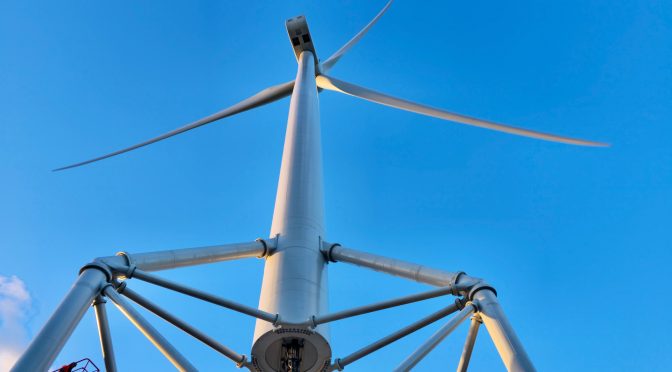
Nabrawind has successfully completed the design and manufacturing evaluation of its new tower family, Nabralift 3.0, as well as the first prototype. The Component Certificate has been issued by UL Solutions and delivered today at WindEurope 2024 in Bilbao.
The versatile 3.0 tower family includes six different configurations, adapting to various heights ranging from 100 m to 200 m, ideal for turbines over 6 MW. The assembly of the first Nabralift 3.0 tower was completed in late 2023 in Le Portel, France, as part of a project in collaboration with the French company Innovent and integrated with the Vensys 3.8-126 turbine.
Another recent milestone for this tower has been obtaining certification of the adaptation of the generic design to a specific turbine (Vensys 126-3.8 MW, installed in Le Portel). Adaptations for other turbines of 5-6 MW are already ongoing.
The new generation of Nabrawind towers enters the wind market at a strategic moment, aligning with the growing trend towards the installation of wind towers exceeding 200 meters. Currently, there are no technically or economically viable alternatives for these tower heights using conventional technologies based on tubular solutions of concrete or steel. This shift in focus responds to the urgent need to maximize energy capture in low-wind areas, which, in many locations, involves significantly raising the hub height.
Nabralift 3.0 Certified
Nabralift is an innovative self-lifting tower technology for wind turbines that overcomes limitations in the growth of turbine hub height. This structure consists of a three-column framework installed beneath the top of a tubular tower of a wind turbine, incorporating a Self-Erecting System (SES) that facilitates the complete installation of the wind turbine (tower, nacelle, rotor) without relying on large-scale cranes. The new 3.0 family incorporates improvements identified in previous projects, achieving weight reduction, enhanced logistics, more efficient assembly, and the ability to support turbine loads of over 6 MW, with rotors exceeding 180 meters.
All towers in the 3.0 tower family share the same transition piece and vary in the number of modules in the lower structure (from 0 to 5). The resulting 6 tower models have already been certified by UL Solutions according to international wind regulations.
The Spanish company Nabrawind will install new Nabralift towers between 2024 and 2025 in Namibia, China, and South Africa.
Le Portel Project
Le Portel is one of the early wind parks developed by Innovent, where four 750 kW turbines have been in operation since 2001. This park has now been redesigned by the French company based in Lille, replacing the old turbines with a 3.8 MW tower.
The park is located on an artificial breakwater, making the design and execution of a conventional foundation challenging. The use of the Nabralift tower has addressed several of these challenges, reducing the concrete needed in the foundation by over 70%.
The Le Portel project is a great example of the circularity in wind energy activity: the four old turbines are being recycled, with metallic components being sorted for a 95% valorization rate, electrical components such as high-voltage cells are reused as spare parts, and turbine blades made of composite materials will be repurposed in urban furniture or undergo thermal recovery through crushing for use as cement fuel.
Advantages of Installing a Nabralift Tower
Thanks to the Nabralift 3.0 tower, all barriers of XXL towers are overcome, along with other benefits that make this wind solution the best alternative for installing tall towers:
Drastic cost reduction. The total cost of the tower (including foundation, logistics, and installation) is reduced by 15-30%.
Crane-free installation. The self-erecting system eliminates the need for large cranes regardless of the final hub height and allows turbine installation at wind speeds of up to 15 m/s.
Logistics-friendly. The modular approach of the Nabralift tower limits the maximum diameter of all components to 4.3 m, even for final hub heights of 200 m. Consequently, all barriers associated with transporting large pieces are eliminated.
Environmentally friendly. Greenhouse gas emissions are reduced by 40% compared to traditional concepts due to the decreased use of concrete and rebar in the foundation, as well as the reduction in the mounting platform area and the use of steel as the main tower component, which is entirely recyclable.